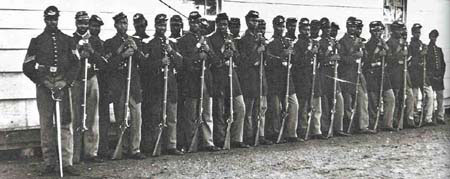
In Petersburg
At the beginning of the Civil War, Virginia had a black population of about 549,000. This meant that of the Confederacy's total black population 1 in every 6 blacks lived in Virginia. Of those African-Americans in Virginia 89% were slaves. In Petersburg about half the population was black of which nearly 35% were free. Petersburg was considered to have the largest number of free blacks of any Southern city at that time. Many of the freedmen prospered here as barbers, blacksmiths, boatmen, draymen, livery stable keepers and caterers.
Serving the Confederacy
When Petersburg became a major supply center for the newly formed Confederacy and its nearby capital in Richmond, both freedmen and slaves were employed in various war functions. One of which was working for the numerous railroad companies that operated in and out of the city. In 1862 Captain Charles Dimmock used freedmen and slave labor to construct a ten-mile long defensive line of trenches and batteries around the city.
Once the siege began in June 1864, African-Americans continued working for the Confederacy. In September 1864, General Lee asked for an additional 2,000 blacks to be added to his labor force. In March 1865, with the serious loss of white manpower in the army, the Southern army called for 40,000 slaves to become an armed force in the Confederacy. A notice in the April 1, 1865, Petersburg Daily Express, called for black recruits with the statement, "To the slaves is offered freedom and undisturbed residences at their old homes in the Confederacy after the war. Not freedom of sufferance, but honorable and selfwon by the gallantry and devotion which grateful countrymen will never cease to remember and reward." It is not known how many responded to this challenge. The war ended before any major contribution could be made.
Serving the Union: U.S. Colored Troops in the Siege
During the war a total of nearly 187,000 African-Americans served in the Union army. Of those the greatest concentration of U.S. Colored Troops (USCT) was at Petersburg. In the initial assault upon the city on June 15, 1864 a division of USCTs in the XVIII Corps helped capture and secure a section of the Dimmock Line. The other division at Petersburg was with the IX Corps and it fought in the Battle of the Crater, July 30, 1864.
In December 1864, all the United States Colored Troops around Petersburg were incorporated into three divisions and became the XXV Corps of the Army of the James. It was the largest black force assembled during the war and varied between 9,000 to 16,000 men. Overall in the Petersburg Campaign USCTs would participate in 6 major engagements and earn 15 of the 16 total Medals of Honor awarded African-American soldiers in the Civil War.
At City Point
African-Americans served in varying capacities at the Union supply base at City Point. They served as pickets, railroad workers, and laborers "discharging the ships, wheeling the dirt, sawing the timber and driving the piles." Many also worked at the Depot Field Hospital as cooks.
|






